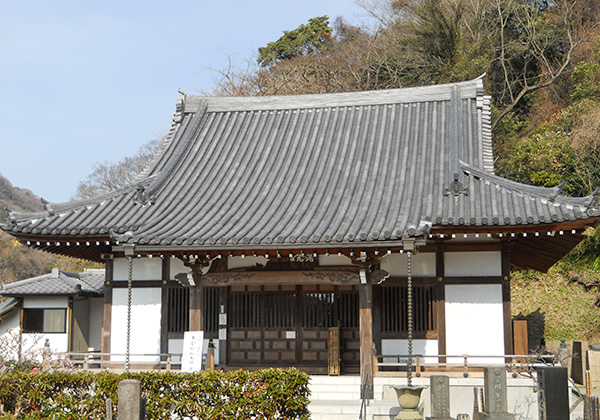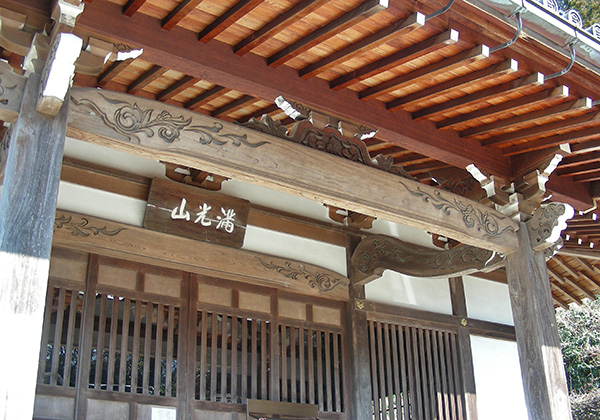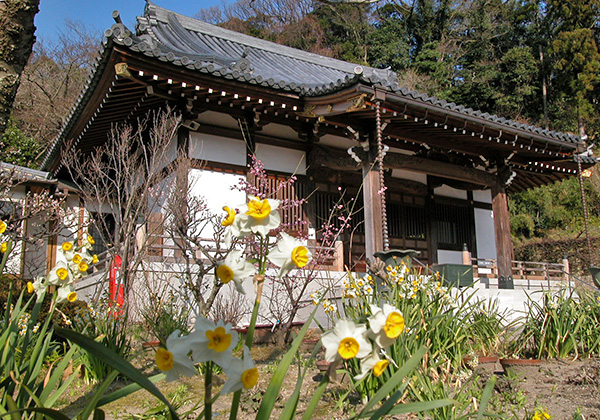Raikoji
| Official Name | Mankozan Raikoji {Pronounced man-ko-zan rye-ko-ji} |
|---|---|
| Religious sect | Ji {gee} Sect, Buddhism |
| Founded | in circa 1280 by unknown |
| Founding priest | Chishin Ippen {chee-shin (h)ip-en} |
| Main object of worship | Statue of Amida Nyorai {ah-me-dah nyo-rye} |
| Address | 11-1, Nishi-Mikado 1-chome, Kamakura, Kanagawa 248-0004 (show route from current location ) |
| Location | 1,500 meters northeast of Kamakura Station |
| Time needed to get there | 20 minutes |
| Admission | Main Hall 500yen(By appointment only) |
| Open | By appointment only |
| Phone number | 0467-23-3195 |
Historical Overview
The Temple is thought to have been erected circa 1289 since Priest Ippen (1239-1289), the founding priest, visited Kamakura in 1289. He is also the founder of Ji sect Buddhism, of which head temple is Yugyoji located in Fujisawa, adjacent city to Kamakura.. Priest Ippen started his Buddhist career studying at Enryakuji, the mecca of Tendai Sect, but later began to believe in the Jodo sect or the Pure Land Buddhism. Those days, people were suffering from various hardships caused by poverty, famine, epidemic, drought, civil wars and natural disasters. They were disappointed in their daily life and sought the paradise after death or rebirth in the paradise.
According to Jodo Sect preaching, Amida Nyorai (Amitabha in Sanskrit) and Bodhisattvas would appear at the moment of one's death and lead him or her to the Western Paradise should they believe in the Amida Buddha. There are a number of pictures beautifully and realistically painted those days that show the Amida trinity and 25 Bodhisattvas descending from the heaven to welcome the dying devout into the Pure Land.
Priest Ippen advanced the Pure Land concept further, saying that reciting the name of the Amida Buddha, or "Nam-amy-dash-boots" called nembutsu {nen-boo-ts}, give salvation to the faithful while they are alive, not after death. Later in 1279, he combined Nembutsu with dancing. This ecstatic dancing and nembutsu, easiest to practice among any sects, won a great popularity from the general populace. With his devotion and self-sacrifice, he travelled throughout the country as referred to as a wayfaring priest or a priest of abandonment, and came to Kamakura, the nation's capital, in 1289 to spread his faith. Although denied to enter Kamakura by the Hojo Government, he was well accepted by the people in Fujisawa, and gained momentum gradually. As a matter of fact, Ji Sect was at the forefront of Japanese Buddhism in the 14th and 15th century. In Kamakura, there are seven Ji sect temples including Kosokuji in Juniso and Betsuganji, which are introduced in this home page.

Main Hall and Statues

The hall as well as the priest's living quarter is rather new built in the mid 1990s. Enshrined inside the hall are the following:
A statue of Amida Nyorai, the main object of worship, curved in 1712.
A sedentary statue of Nyoirin Kan'non (Cintamanicakra in Skt.) fashioned in the mid-14th century. Originally, the statue was enshrined at Hokkedo {ho'ckeh-doh} Hall (the prayer hall for Yoritomo Minamoto, the founder of Kamakura Shogunate. No longer exists), but was brought here shortly after the Meiji Imperial Restoration of 1868 following the new Government's instruction to segregate Shinto from Buddhism. The statue is half cross-legged and has six arms to demonstrate that she can save those who are suffering in the netherworld. According to the Buddhist teaching, we are destined to go, immediately after death, to one of the Six Stages of the World: Hell, World of Preta (hungry ghost), Realm of Beasts, World of Asura, Human Being and Heaven. Each arm of Nyoirin Kan'non is allocated to save those wondering souls in that particular world. One of the right hand touching her cheek, for example, is for those in the Hell, and another right hand with a peach-shaped fitting called Hoju (Mani in Skt.) in her palm is to save those in the world of Preta. The statue is well-known with its unique decoration called Domon {doh-mon}. It has patterns of flowers, peony and chrysanthemum in this case here, put on the statue's robe to make it appear gorgeous. These are made of colored clay and pasted with lacquer. Patterns are created by molds to shape the decoration. Domon decoration is found only in Kamakura and cannot be found anywhere else. The statue is an ICA designated by the Prefectural Government of Kanagawa, and ranks fifth of the Kamakura Thirty-Three Kan'non Pilgrimage.
A sedentary statue of Jizo Bosatsu (Ksitigarbha-bodhisattva in Skt.) .This 131-centimeter-tall statue is believed to have been carved by an excellent local sculptor named Joko Takuma {joe-koh tah-koo-mah} (birth and death years unknown), who played a conspicuous part in the 14th century. Originally, it was installed as the main object of Ho-onji {hoh-on-gee} , a Zen temple founded in 1371 somewhere near here, but was later abandoned. The statue is also an ICA designated by the Prefectural Government and placed second in the Twenty-Four Kamakura Jizo Pilgrimage.
At the corner of the hall is a standing statue of Batsudabara {bah-tsu-dash-bah-rah} or Bhadra in Skt., one of the 16 Rakan (Arhat in Skt.).
An Episode of the Batsudabara statue
Here is an interesting episode in connection with the statue, It was modeled after a high-ranking priest at Kenchoji by name of Jikyu {gee-kyoo}. At the time he was the chief priest of a sub-temple called Kotokuan in Kenchoji, he fell in love with a boy servant at Tsurugaoka Hachimangu Shrine. Boy servants are called Chigo {chee-goh} in Japanese, and pretty Chigo sometimes were kept by pederasts. Believe it or not, the priest practiced pederasty and he approached the Chigo to coerce him into sexual relations. Astonished, the boy fled to Enoshima {eh-no-she-mah}, a tiny island off the coast of western Kamakura, and took his own life by throwing himself into the water. (Hence the name of Chigo-ga-Fuchi at Enoshima). Immediately, Priest Jikyu followed suit and committed suicide.



